This No-Knead Dutch Oven Sourdough Bread is the perfect recipe for those just learning how to make sourdough bread. All you need is an active sourdough starter, bread flour, water, and kosher salt.
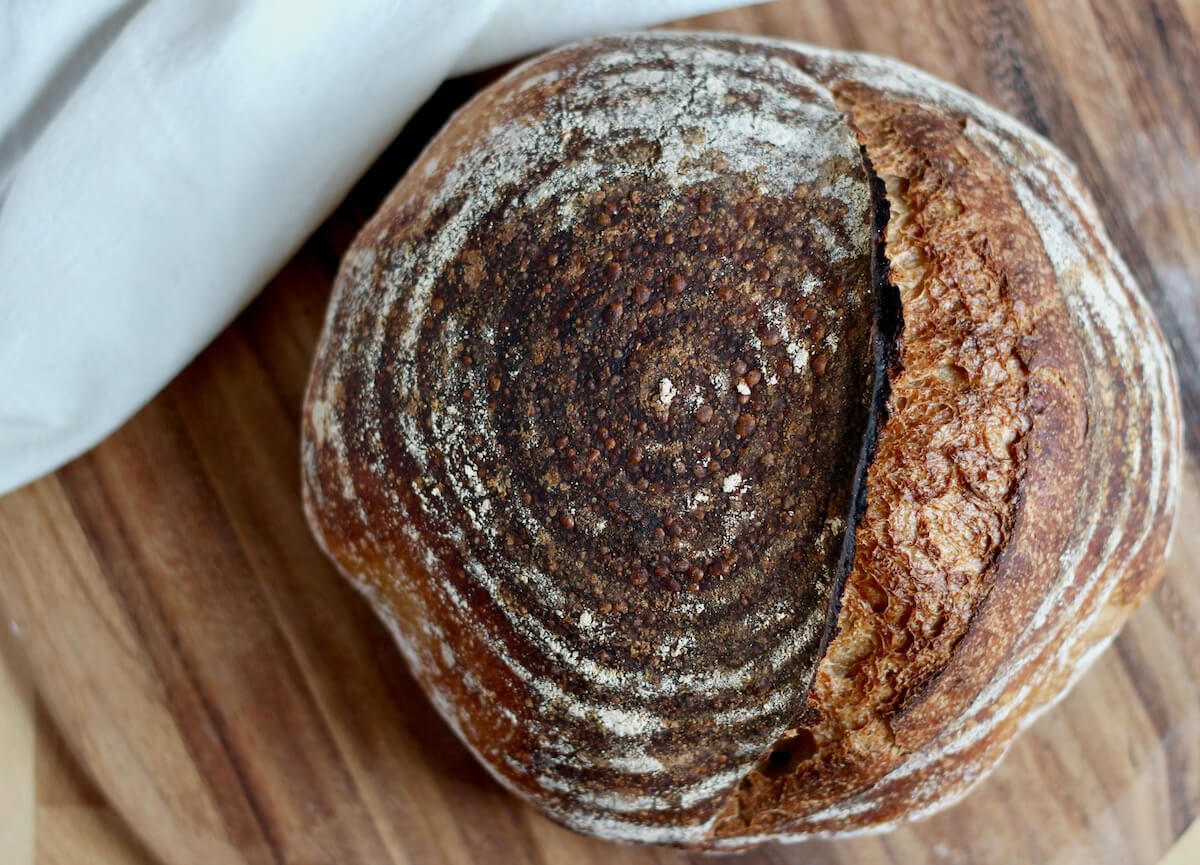
There's nothing better than a crusty, rustic loaf of sourdough bread. Known for its distinct tangy flavor and chewy texture, sourdough bread is well-loved by many home bread bakers.
But, let's be honest, baking sourdough bread at home can be a bit intimidating, especially if you're new to it. It took me months before I could finally make a good loaf of sourdough bread.
This no-knead Dutch oven sourdough bread recipe is a great starting point for beginners who are new to baking with sourdough. With a strong and healthy sourdough starter, this recipe is practically fool-proof.
I wrote this blog post to be a beginner's guide to sourdough bread. So, if you're confident in your sourdough skills, feel free to jump down to the recipe! Otherwise, keep reading to learn all of my best sourdough tips and tricks.
Disclaimer: Some links throughout this post are affiliate links. As an Amazon Associate, I earn from qualifying purchases. You can learn more by visiting my Affiliate Disclosure Page.
Understanding Baker's Percentages
Before we dive into making a loaf of no-knead sourdough bread, it's important to understand baker's percentages. For me, learning about baker's percentages was a game-changer for my sourdough bread baking.
Baker's percentages (or baker's math) are used to develop bread recipes. These percentages compare the amount of each ingredient in the recipe as it relates to the amount of flour. The flour is always set at 100%.
Baker's Percentages Formula: (weight of ingredient [in grams]/weight of flour [in grams]) X 100 = baker's percentage
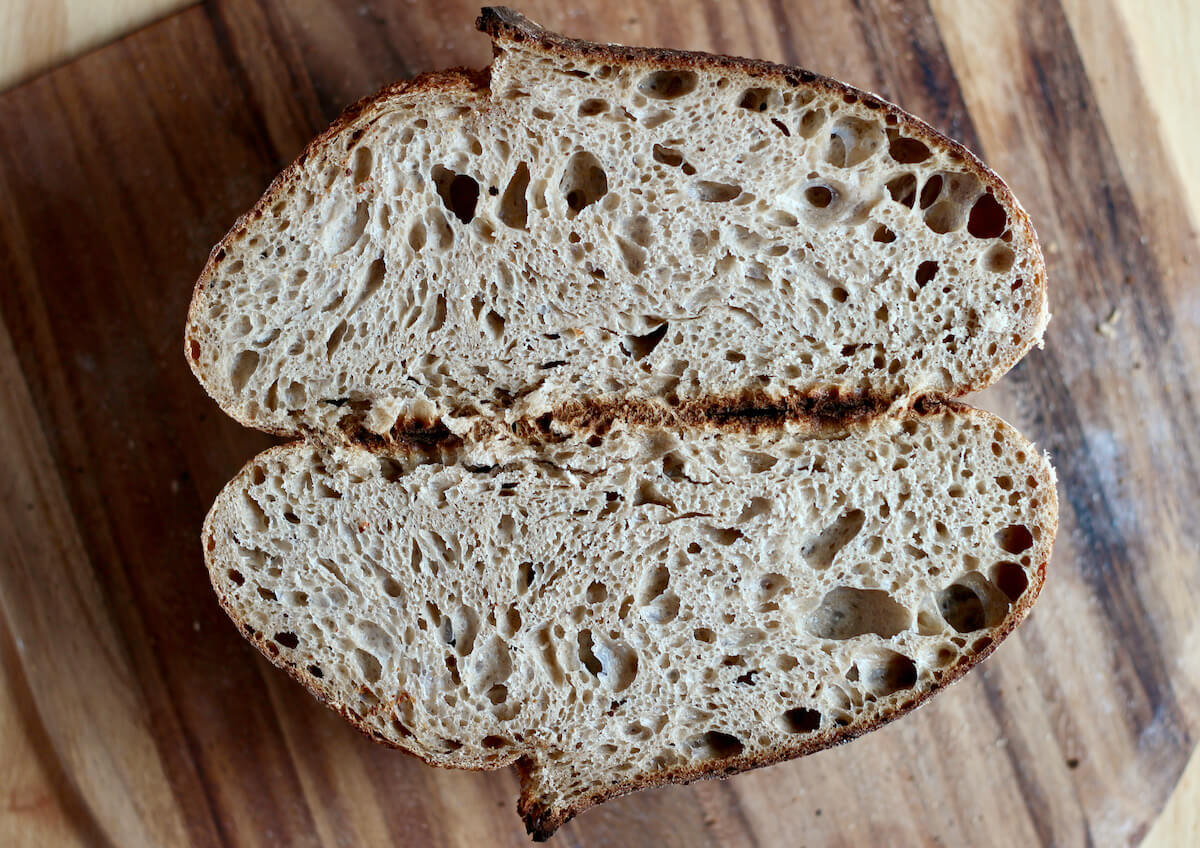
Example Formula Using Baker's Percentages
A basic loaf of sourdough bread is made using only flour, water, starter, and salt.
Typically, sourdough bread formulas use 20% starter, 2% salt, and anywhere from 60-100% water. The amount of water in the recipe is often referred to as the hydration level of the dough.
Here is a table showing the breakdown of baker's percentages for this Dutch oven sourdough bread recipe.
| Ingredient | Amount | Percentage |
| Flour | 500 grams | 100% |
| Water | 375 grams | 75% |
| Starter | 100 grams | 20% |
| Salt | 10 grams | 2% |
Understanding Hydration Level
As previously mentioned, the amount of water in the dough is often referred to as the hydration level. Sourdough bread recipes can range anywhere from 60-100% hydration. The dough in this Dutch oven sourdough bread recipe is a "75% hydration dough."
The hydration level of the dough is important because it affects the final texture of your bread. Lower hydration doughs are drier and have a denser, more closed crumb. On the other hand, higher hydration doughs are moister and have a more open and airy crumb.
Hydration level also affects how easy it is to work with your dough. The higher the hydration, the stickier and more difficult it is to work with the dough. If you're new to sourdough, I recommend starting on the lower end and working your way up to higher hydration doughs.
Ingredient Notes
Here are some notes on key ingredients. For a full list of ingredients, check out the recipe card below.
- Sourdough Starter- Your starter should be strong and vigorous before attempting to use it to make a loaf of sourdough bread. Add it to the dough when it's at its peak activity levels, usually about 6 hours after feeding.
- Bread Flour- Bread flour is often used when making sourdough because of its higher protein content. Always use unbleached flour when feeding your starter and making sourdough bread. For a little more flavor, try swapping 50-100 grams of the bread flour with whole wheat flour.
- Water- This recipe makes a 75% hydration dough. If you're new to sourdough and worried about handling wet dough, you can decrease the water in this recipe to 325 grams to make a 65% hydration dough.
- Salt- For flavor. I prefer to use kosher salt.
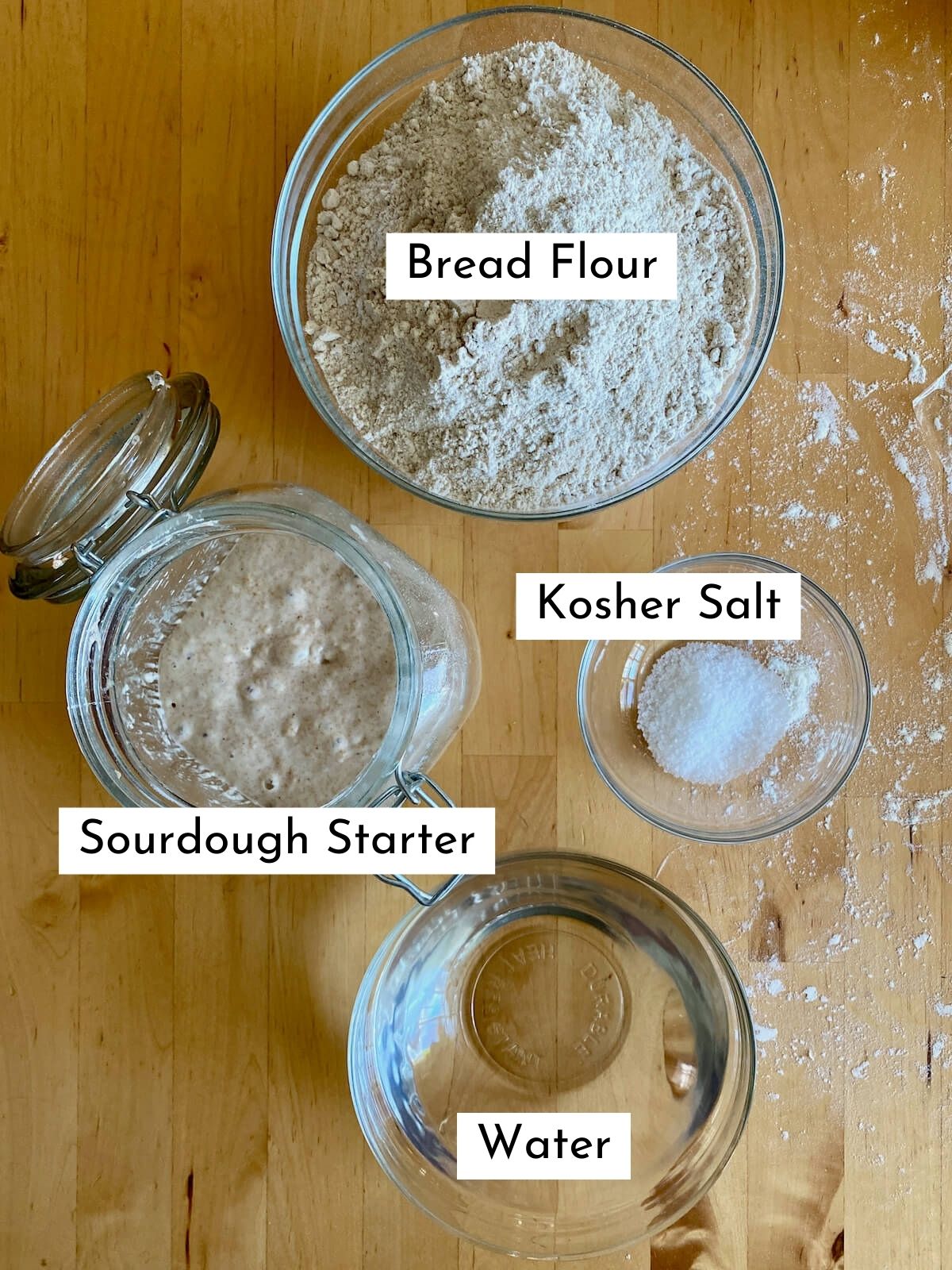
How To Know If Your Sourdough Starter Is Active
So, you made a sourdough starter and have been feeding it regularly for 10-14 days, but how exactly do you know when it's ready to use?
- Bubbles- Lots of bubbles on top of and along the sides of the sourdough starter is a good indication it is vigorous enough to leaven a loaf of bread.
- Size- A strong sourdough starter should double or triple in size after about 6 hours in a warm environment (70-75°F [21-24°C]).
- Doming- If you look at the top of your sourdough starter, you should notice a slight doming when it's most active.
- Aroma- An active sourdough starter will smell yeasty, fruity, and slightly sour. If it has taken on an acetone-like smell, it is hungry and is not ready to leaven bread. If it smells moldy or rotten, it is bad and should be thrown out.
- Float Test- The float test can be used to help determine if your sourdough starter is active enough to leaven bread. To do the float test: gently scoop a small amount of starter out of the jar and carefully add it to a glass of cold water. If the piece of starter floats, you're good to go. If it sinks, it may need more time or it is past peak activity levels and needs to be fed again.
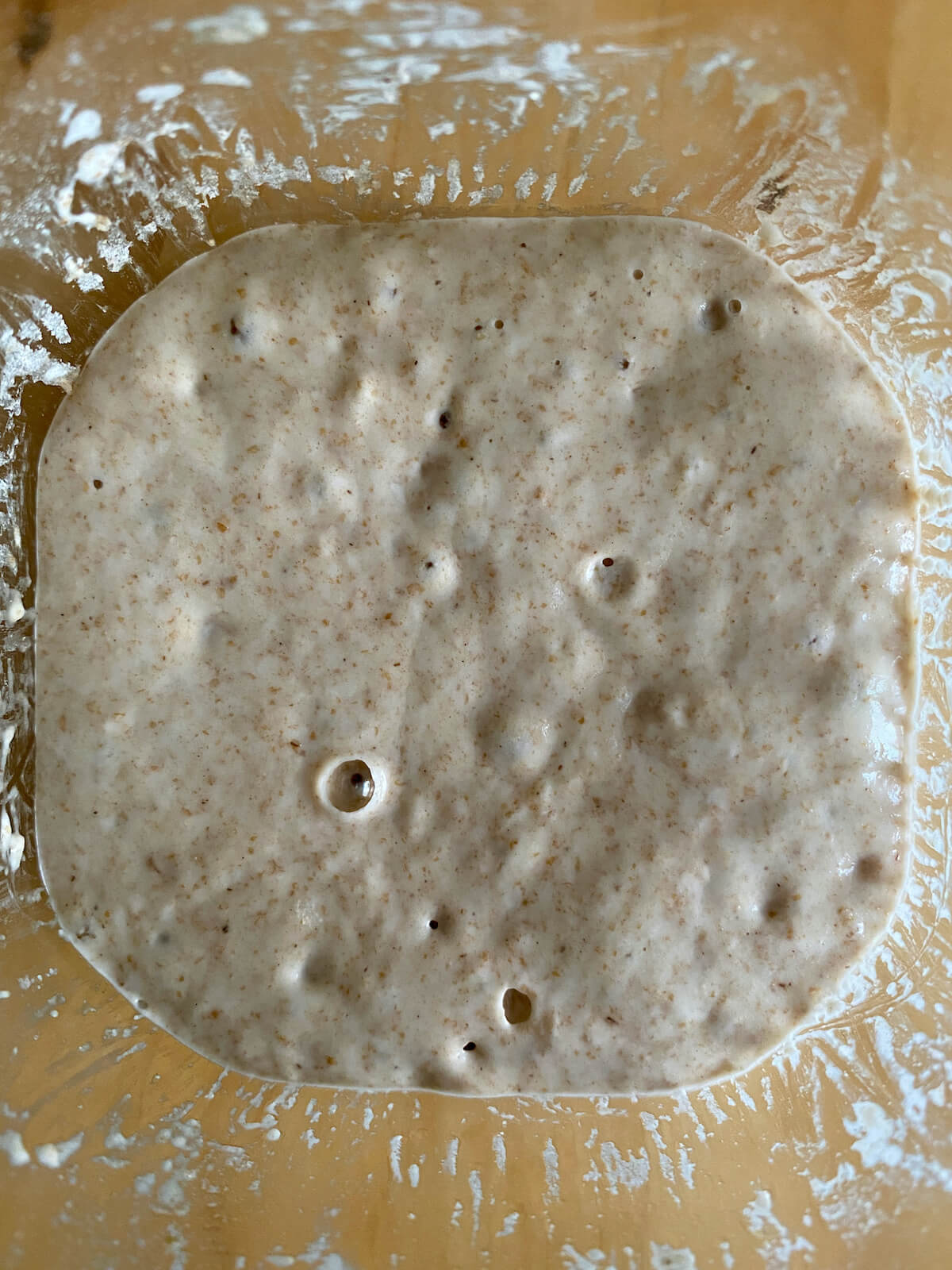
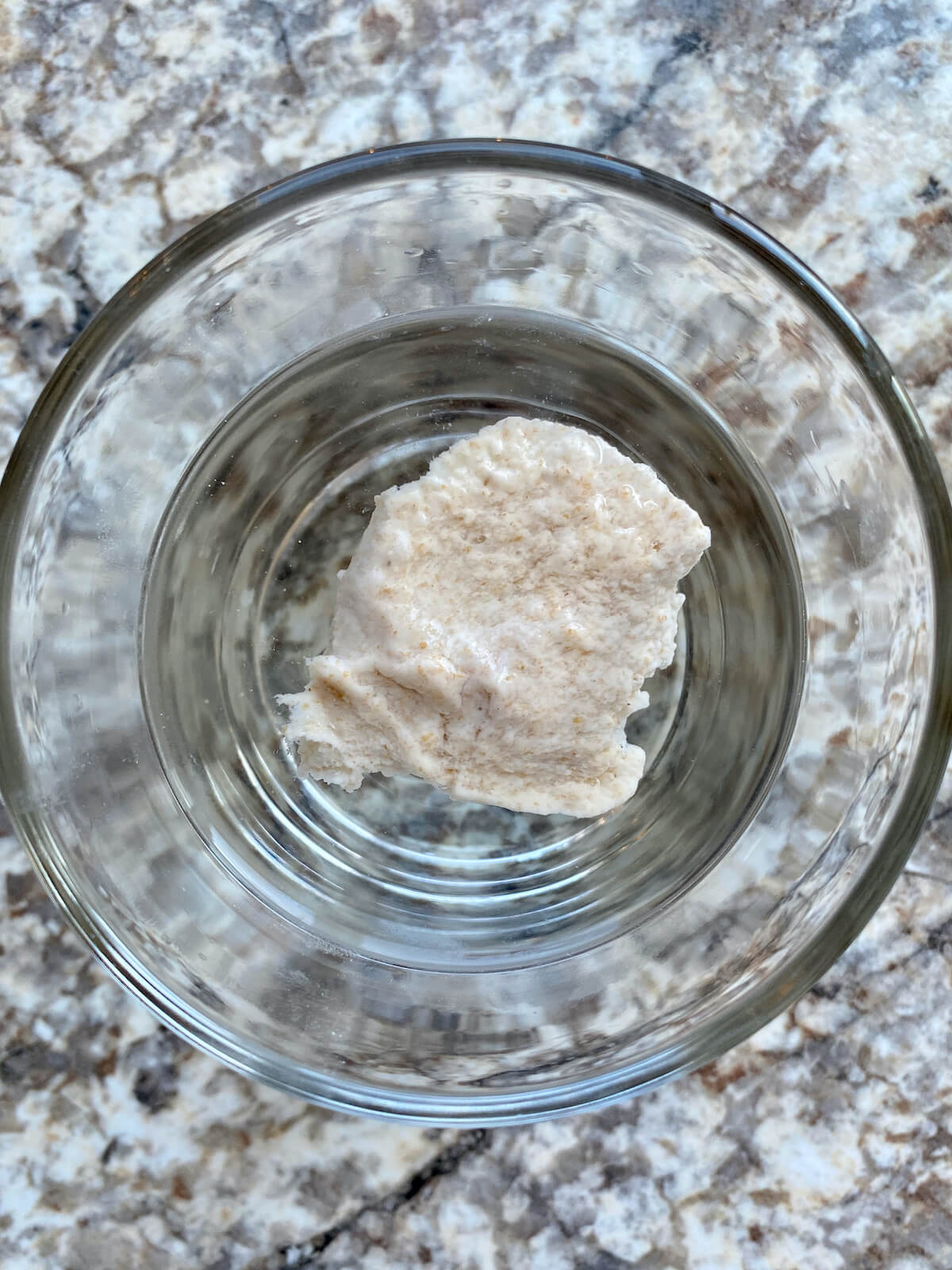
Troubleshooting Your Sourdough Starter
If your sourdough starter seems a little sluggish, here are a few things you can try to give it a boost.
- Use Whole Grains- I find that the yeast and bacteria in my sourdough starter love whole grains. In fact, I was struggling with my starter until I switched to feeding it a mixture of bread flour (50 grams) and whole wheat flour (25 grams).
- Switch Flours- Sometimes we just need to shake things up a little to see a boost in our sourdough starters. If you're feeding your starter all-purpose flour, try using bread flour, whole wheat flour, or rye flour instead. Or do a mix of all of the above.
- Feed It More- When I first created my starter, I was feeding it in a 1:1:1 ratio (25 grams starter, 25 grams flour, 25 grams water). I found that the yeast in my starter were going through this amount of food way too quickly. For me, a 1:3:3 ratio (25 grams starter, 75 grams flour, 75 grams water) works much better and I have an active, bubbly starter about 6 hours after feeding.
- Keep It Warm- Sourdough starter is happiest when stored between 70-80°F (21-26°C).
- Don't Refrigerate- I find my sourdough starter is sluggish for a day or two after I take it out of the fridge. If you're trying to build your starter, I recommend keeping it on the counter until you know it's strong and vigorous.
Equipment Notes
Here are some notes on any special equipment I used to make this recipe.
- Dutch Oven- I always use my Lodge 6-Quart Dutch Oven to bake loaves of sourdough bread. A cast iron Dutch oven is helpful for baking bread because they trap the steam, keeping the sourdough bread crust soft so it can rise higher while baking.
- Kitchen Scale- Sourdough is all about ratios and percentages. Investing in food scale is well worth it if you plan on baking sourdough bread.
- Banneton Basket- A banneton helps the bread dough hold its shape while proofing. To create that classic sourdough boule look, a banneton basket (a.k.a. proofing basket) will be your best friend. I love my Bread Bosses 9-Inch Round Banneton Proofing Basket.
- Bench Knife- A bench scraper acts as an extension of your hand, making the dough easier to handle during shaping. It's also great for cleaning the counter after you're done making your dough.
- Lame- Used to score the dough just before baking. Personally, I just use a razor blade. You can also use a sharp knife.
How to Make Dutch Oven Sourdough Bread
Here is how to make this easy Dutch oven sourdough bread.
Step 1: Feed Sourdough Starter
Feed your sourdough starter in the morning on the day you want to make your dough.
My starter takes about 6 hours to become active and bubbly when it's stored between 70-75°F (21-24°C). This will vary depending on where you store your starter.
Signs to look for include: bubbles breaking on the surface of the starter, the starter doubling or tripling in volume, and a slight doming at the top of the starter. You can also use the float test to check if your starter is ready to be added to your dough.

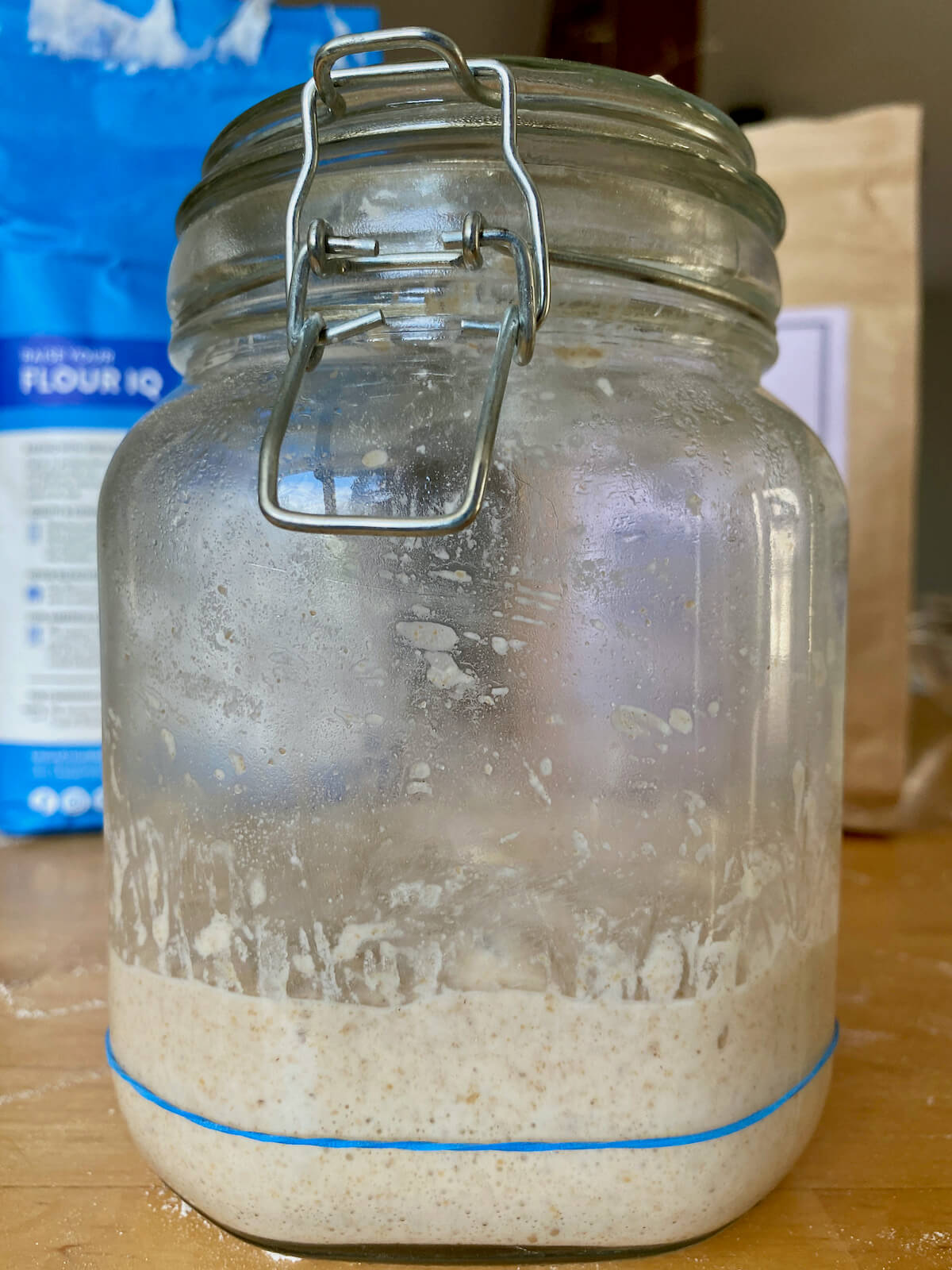
Step 2: Autolyse
The autolyse step allows the flour to fully absorb the water, which helps the gluten structure begin to form. You'll notice a significant change in the texture of the dough after just 30 minutes of resting.
About 30 minutes before your starter is ready, thoroughly mix together the flour and water in a large mixing bowl. Make sure you incorporate the dry flour as best you can, which takes a few minutes of mixing.
After mixing, the dough will look rough and shaggy. Cover with plastic wrap or a damp kitchen towel and allow to rest for 30 minutes or up to 2 hours.
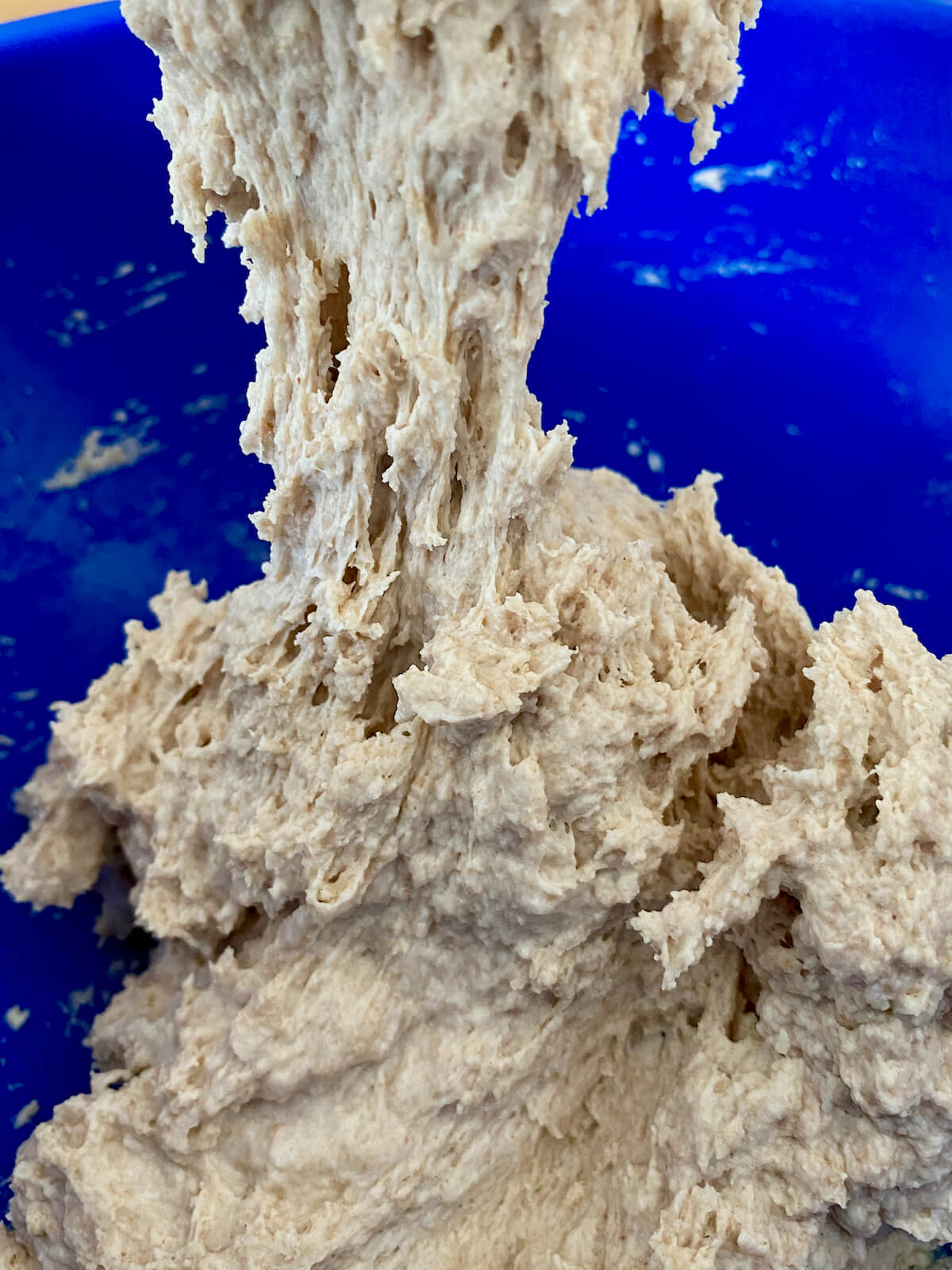
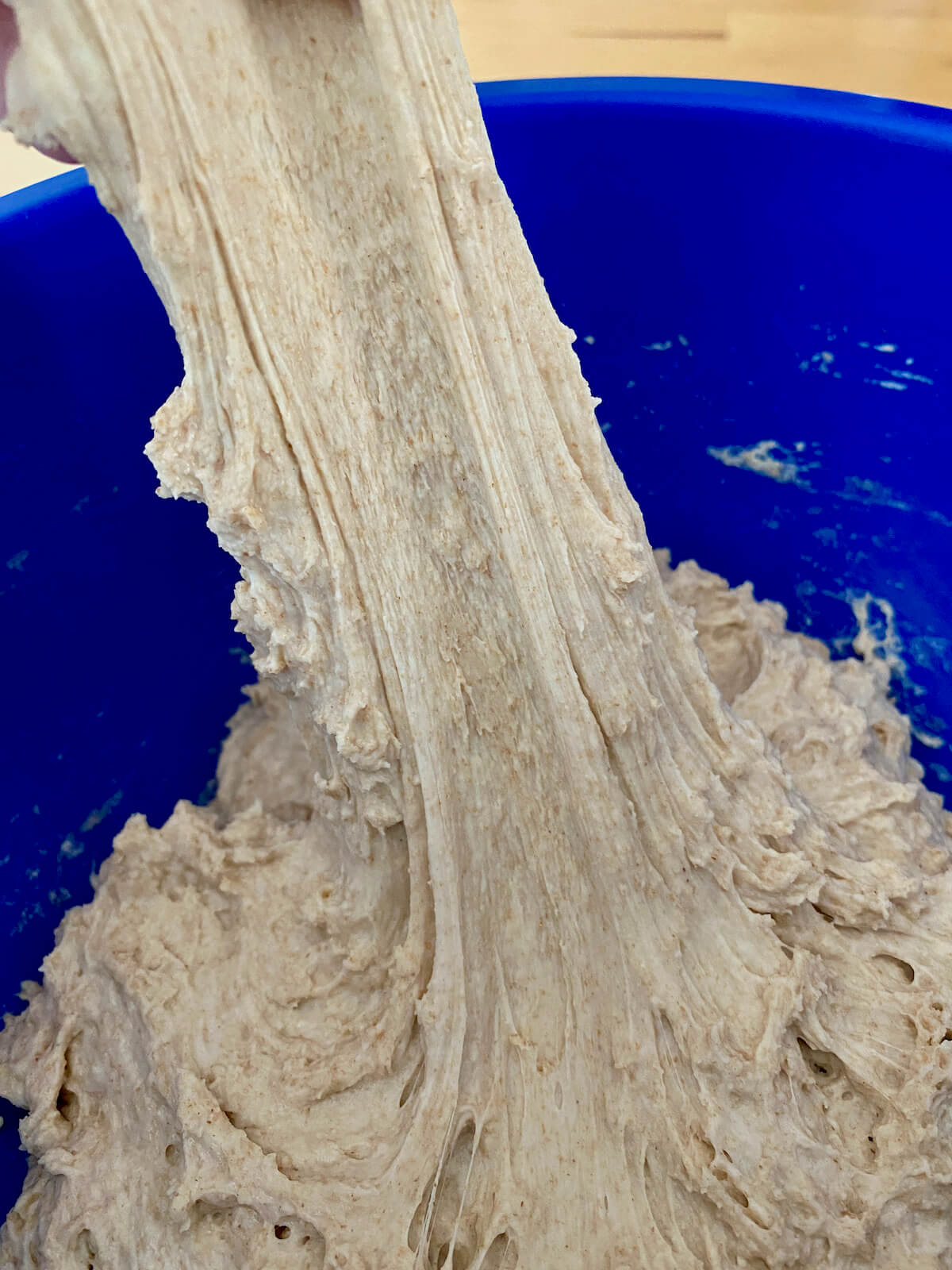
Step 3: Mix the Dough
Once your starter is ready, add it to the bowl with the flour and water. Spread it across the top of the dough, then use your fingertips to "dimple" it into the dough. Pull the dough over itself a few times to begin incorporating the starter.
Then, sprinkle the salt over the dough and continue to squeeze and fold until both the starter and salt are fully incorporated. This will take about 2-3 minutes.
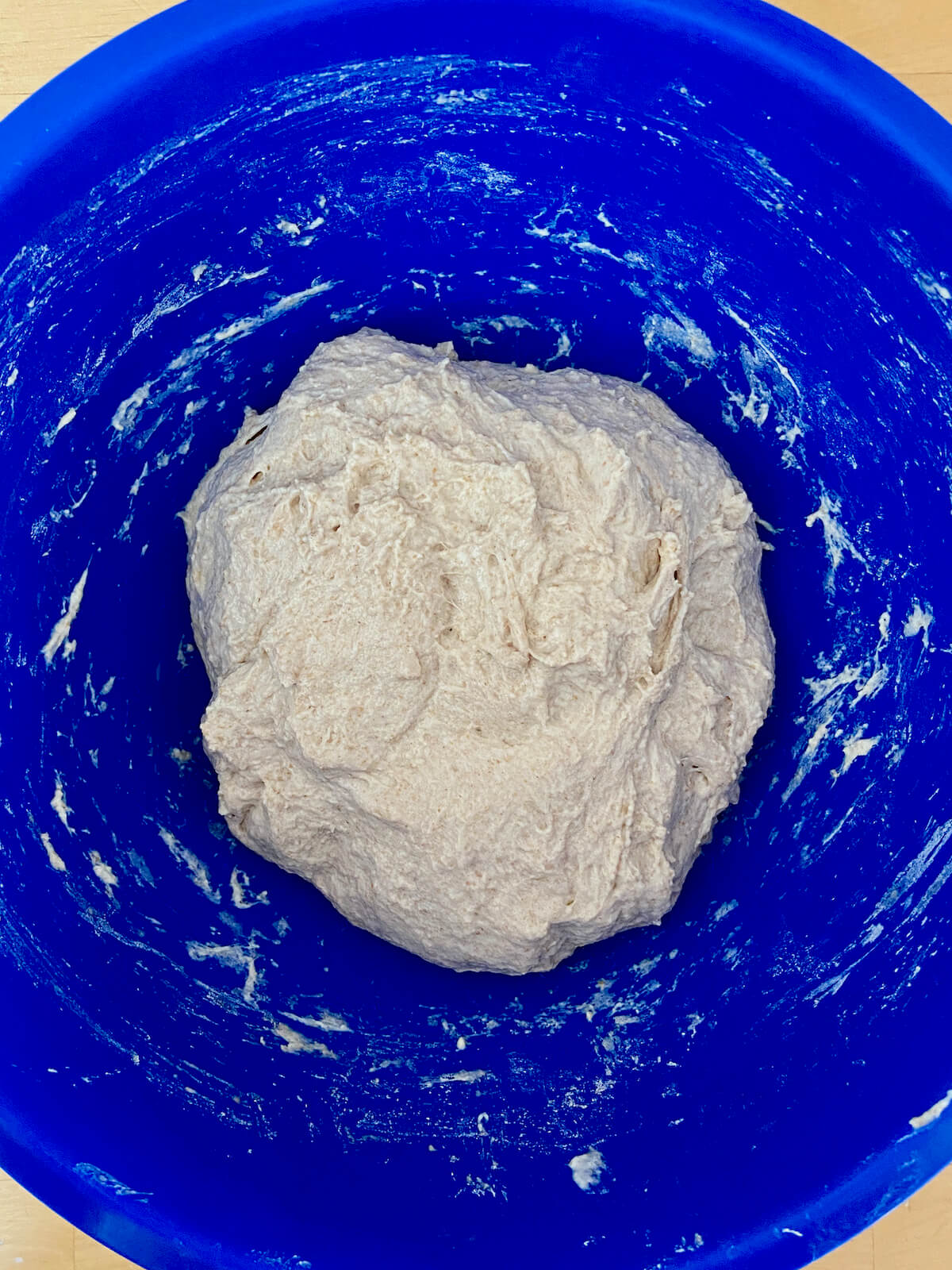
Step 4: Stretch and Folds
Allow the dough to rest for 20 minutes after mixing.
Then, perform your first set of stretch and folds. Do this by dipping your hand into a bowl of cold water before grabbing one edge of the dough and pulling it up as far as it will stretch before folding it over onto itself. Rotate the bowl 90 degrees and repeat. Repeat this stretching and folding two more times (for a total of 4 times) around the dough.
Cover and allow the dough to rest for 20 minutes before performing another set of stretch and folds. Perform 5 sets of stretch and folds total.
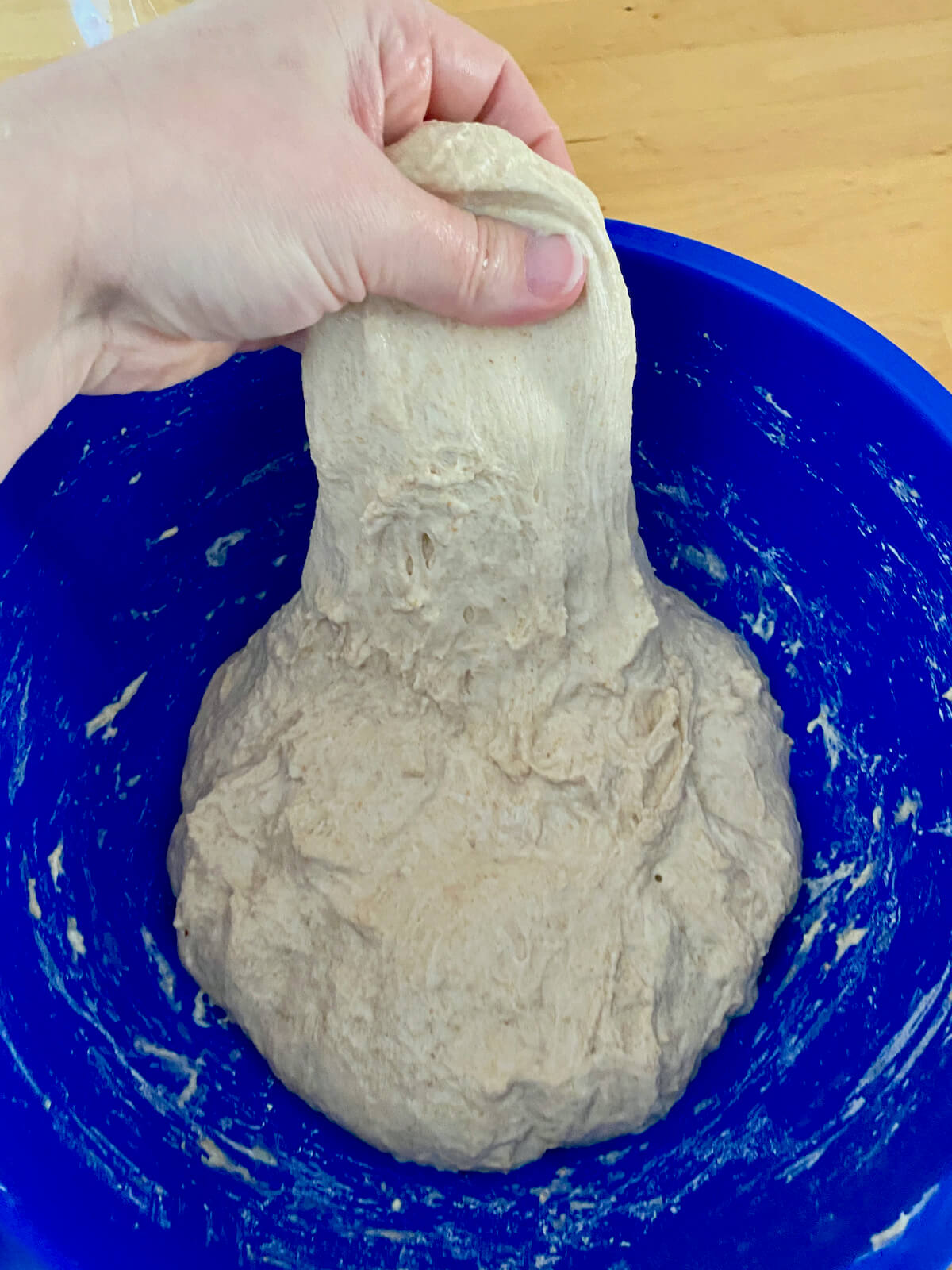
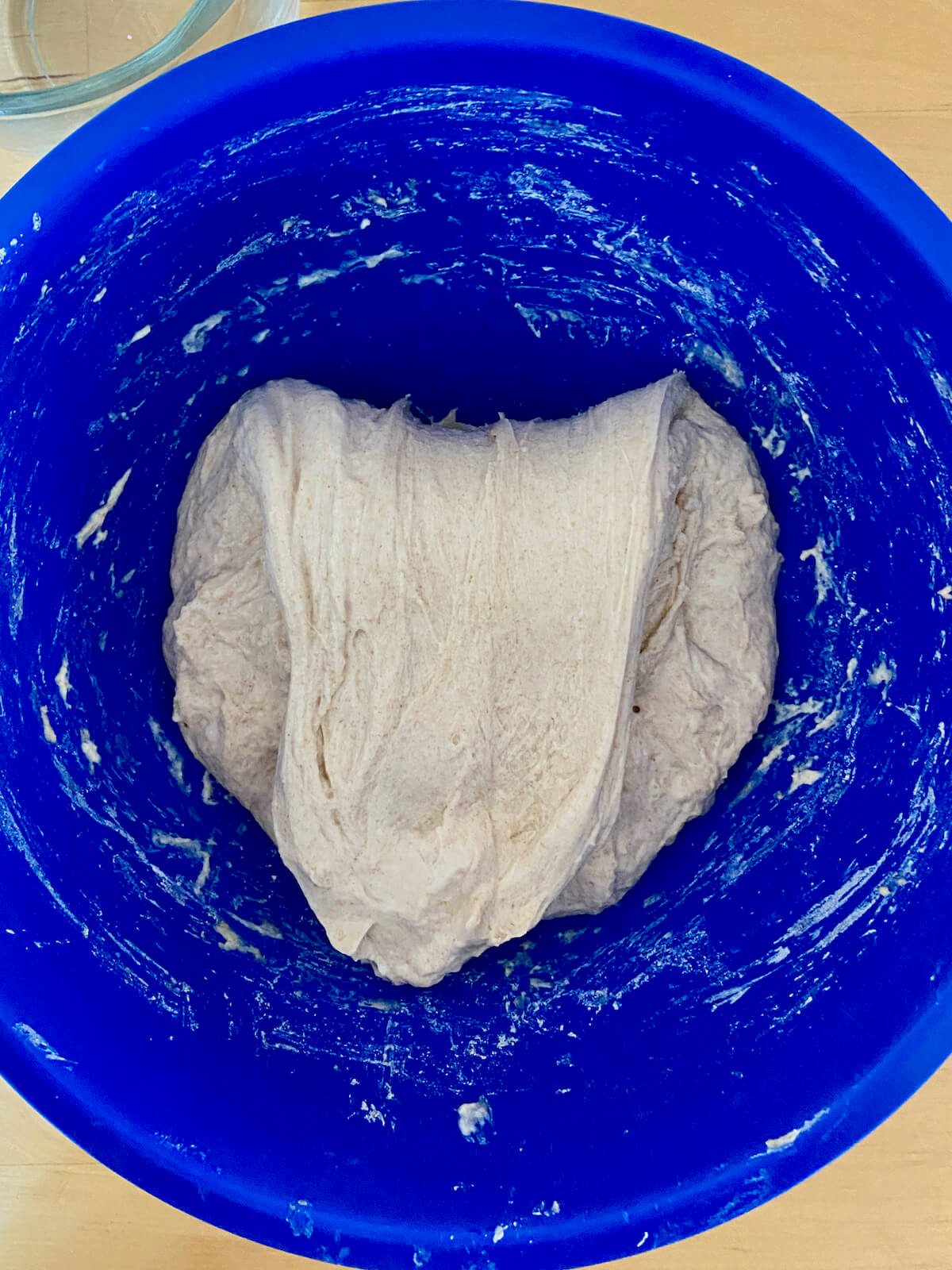
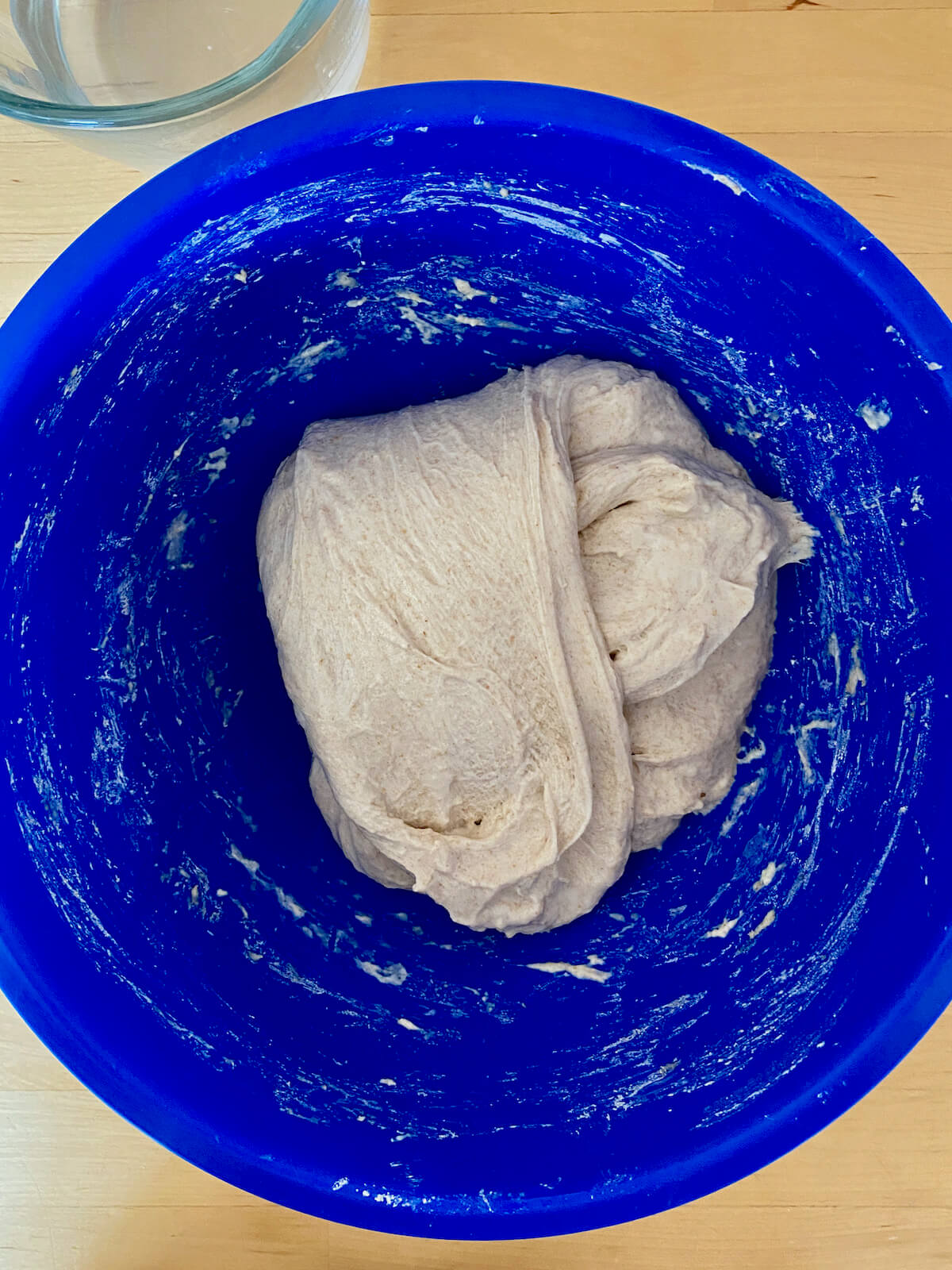

Step 5: Bulk Fermentation
Technically, the bulk rise or bulk fermentation begins as soon as all of the ingredients are mixed together.
Cover the dough and allow it to rise in a warm environment (70-75°F, 21-24°C) for about 4 hours. Your dough is ready when it doubles in size, has bubbles forming on the surface, and jiggles slightly when the bowl is shaken.
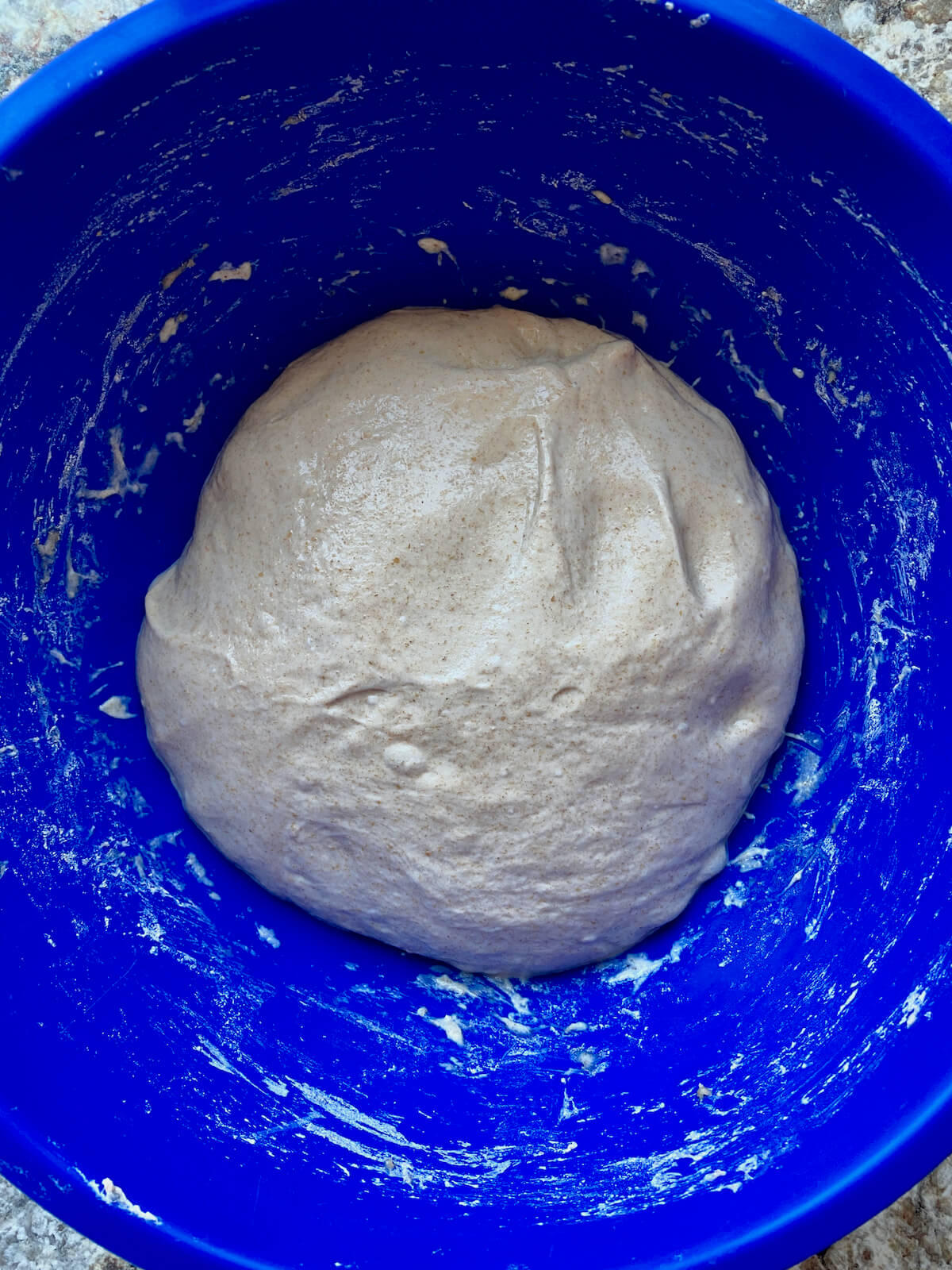
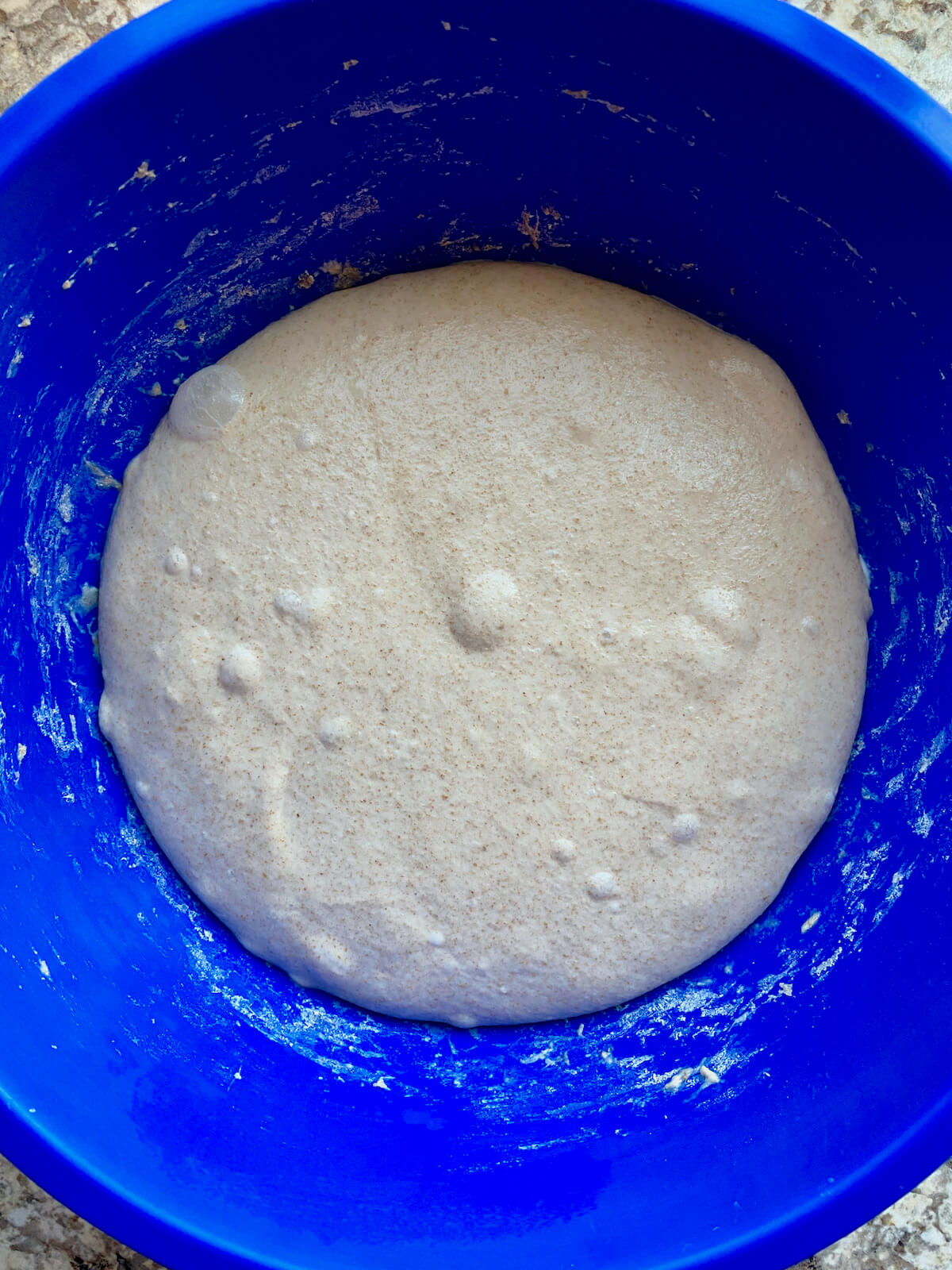
Step 6: Pre-Shape
Pre-shaping starts building tension in the dough and helps get it ready for the final shape.
Carefully turn the dough out onto a lightly floured work surface, taking care not to deflate any of the air built up inside of it. Gently pull the dough into a rectangular shape.
Then, using your hands or a bench scraper, lift one of the short sides of the rectangle, folding it over itself and onto the middle of the dough like a letter. Repeat this fold on the opposite side of the dough. For the longer edges of the rectangle, you'll want to pull the edge of the dough out and up slightly before folding it down onto the middle. Repeat on the other long edge.
Brush away any flour on the work surface before quickly flipping the dough over so the seam side is on the counter. Use your hands or a bench scraper to gently round out the dough into a ball. Cover and allow it to rest for 15 minutes.
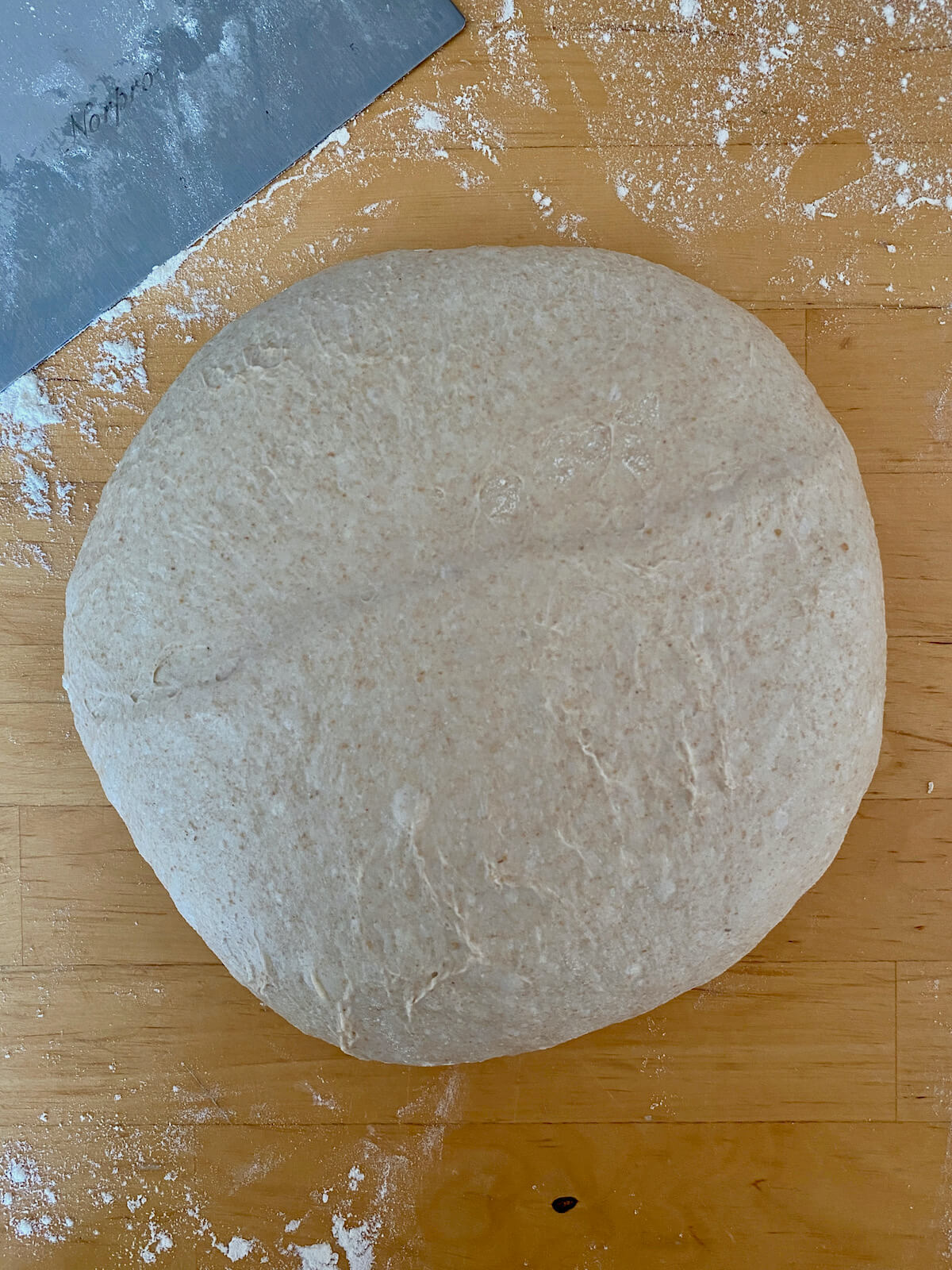
Step 7: Final Shape
During the final shape, you should focus on building more tension in the surface of the dough. Tension helps the bread rise upwards instead of outwards as it bakes.
Lightly sprinkle the top of the dough with flour, then flip it over so the seam side is facing up again.
Repeat the same shaping method followed in the pre-shape step, building a little more tension in the dough this time. Allow the dough to sit seam-side down on the counter for 1-2 minutes before transferring it to a proofing basket.
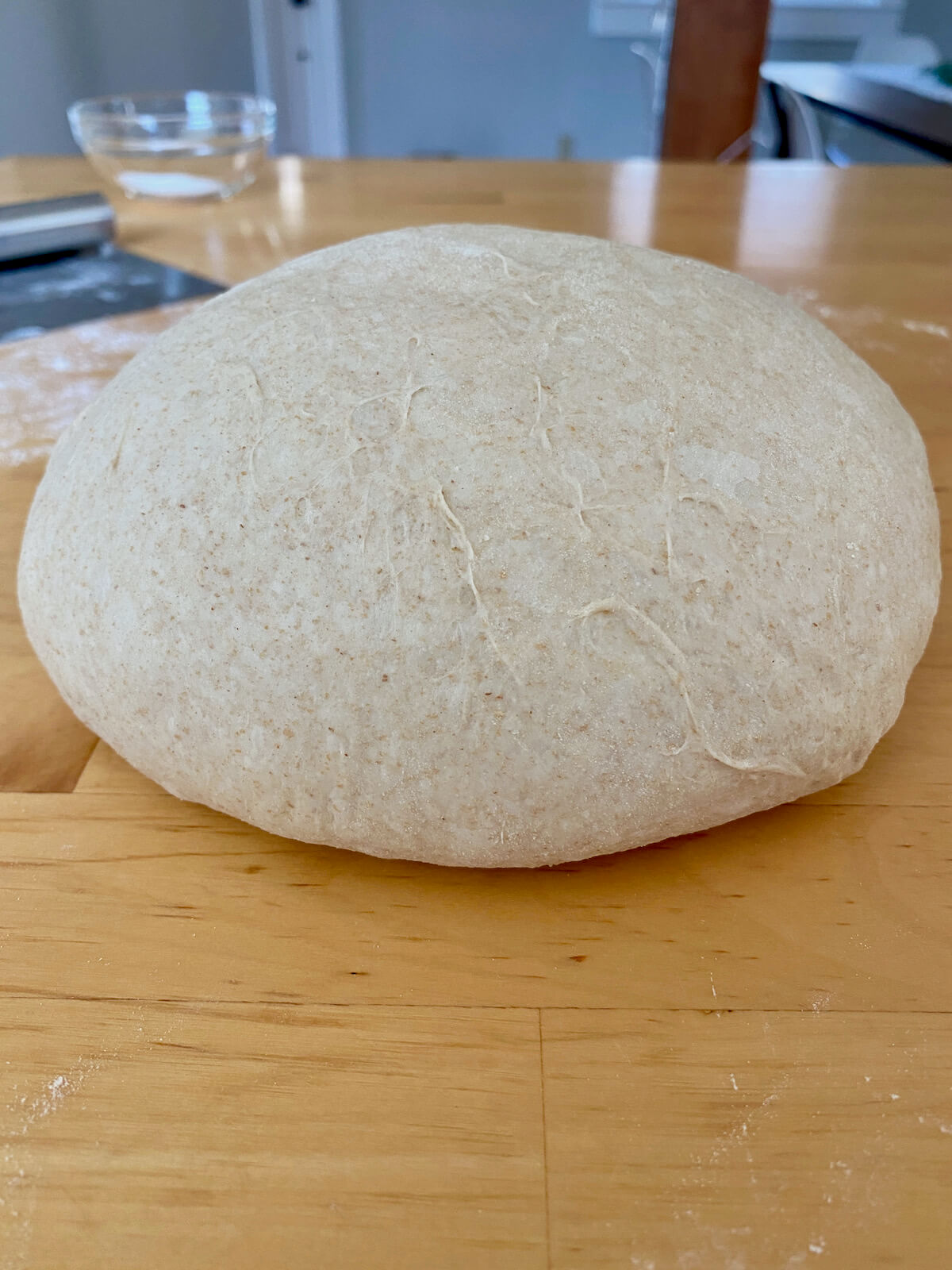
Step 8: Proof
Generously dust a 9-inch round banneton (or tea towel-lined bowl) with rice flour or oat flour.
Quickly turn the dough into the prepared banneton so that the seam side is facing up. Pinch the seam closed with your fingers if it seems to be opening up at all.
Cover and allow it to proof at room temperature for about 30 minutes.
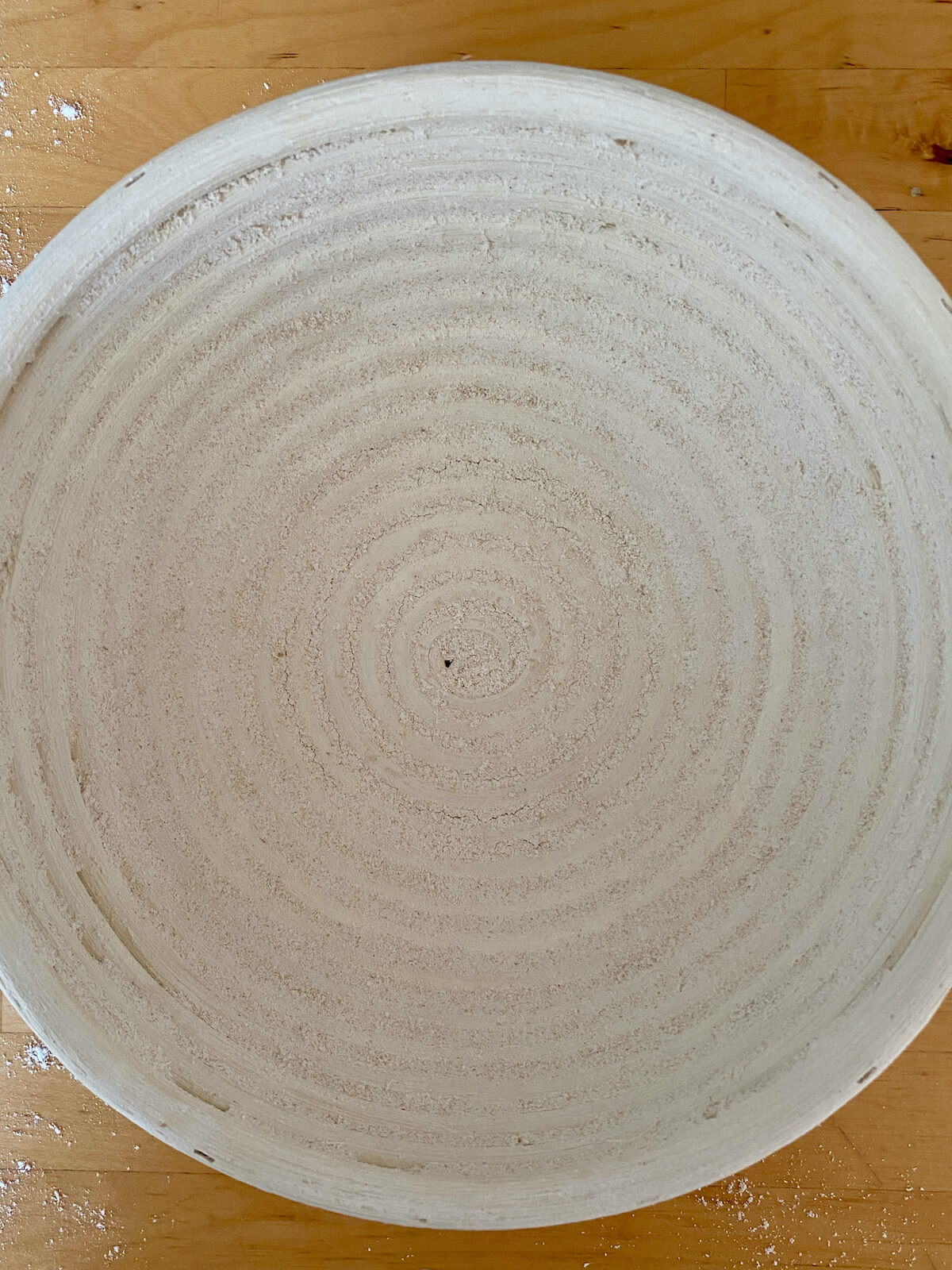
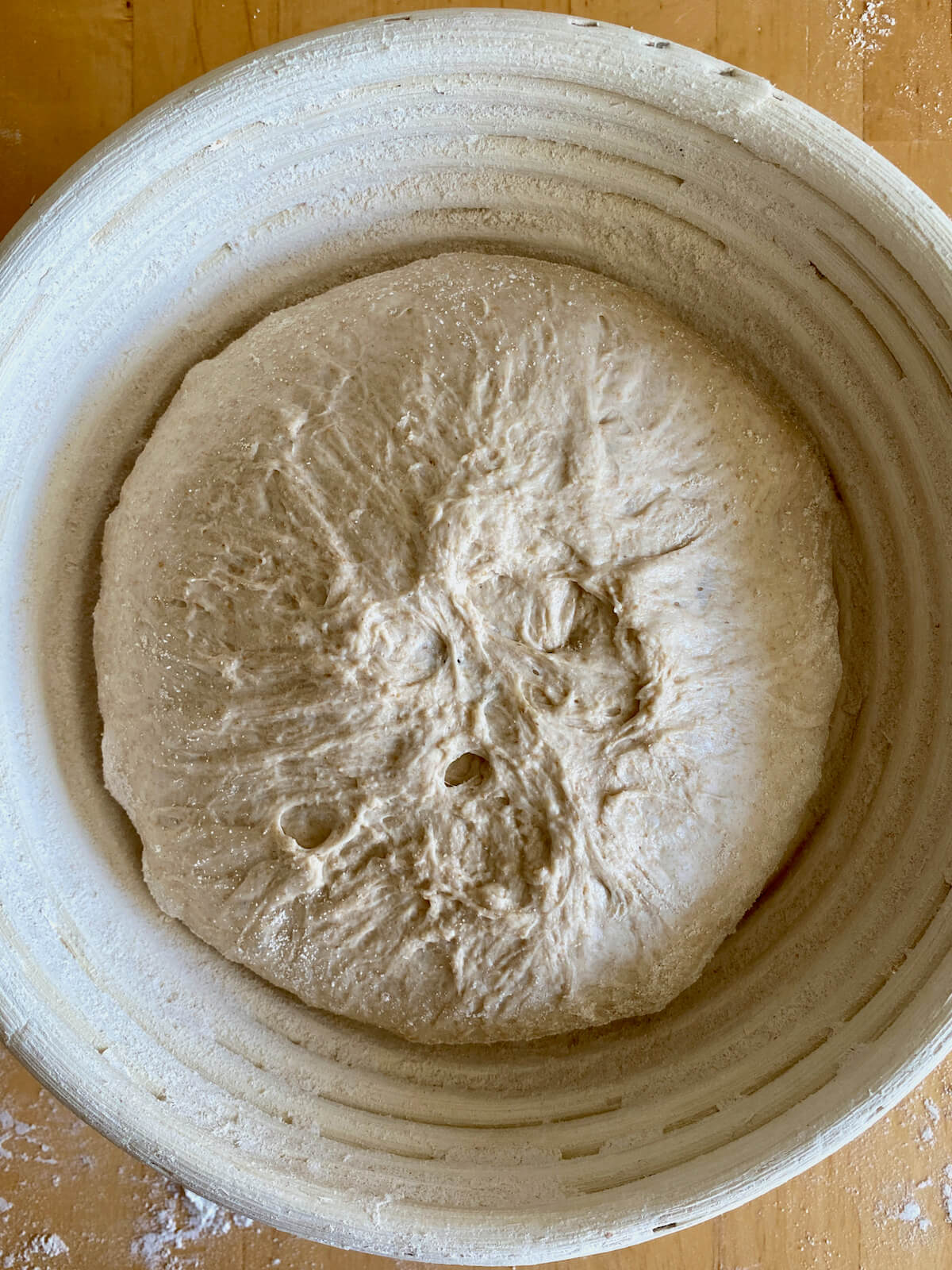
Step 9: Cold Retard
Transfer the proofed dough to the refrigerator to retard overnight. This step helps enhance the classic "sour" flavor of sourdough bread. It also helps the dough hold its shape in the oven.
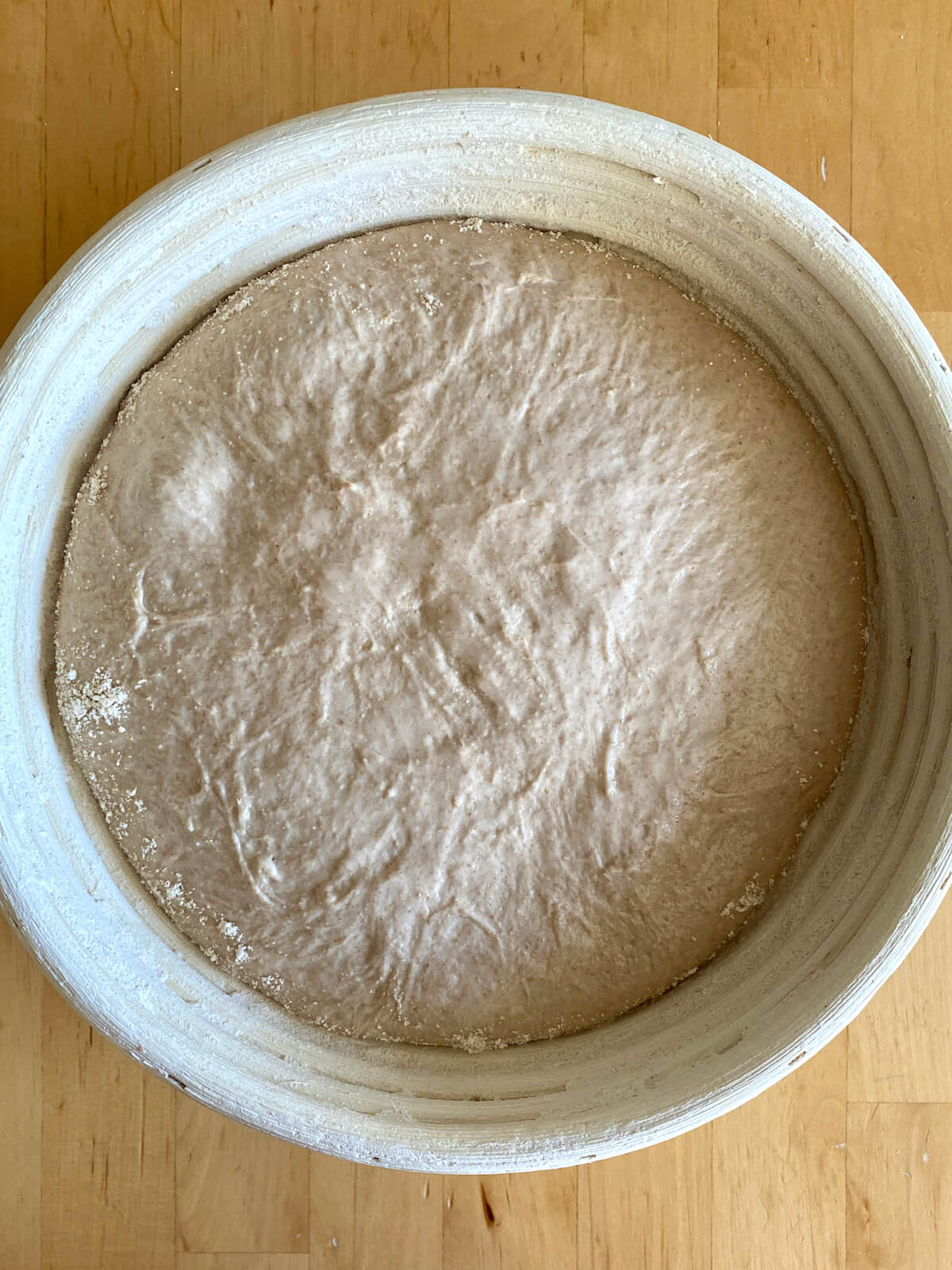
Step 10: Preheat Dutch Oven
About one hour before baking, place your Dutch oven and lid inside of the oven and preheat it to 450°F.
Step 11: Score and Bake
Scoring the bread creates an intentional weak spot to help the bread expand in the oven.
Gently turn your dough out onto a piece of parchment paper. Using a lame, razor blade, or sharp knife, score your bread about ½-inch deep.
Carefully transfer your dough on the parchment paper into the preheated Dutch oven. Quickly cover the Dutch oven and place it back inside the oven. Bake bread covered for 30 minutes. Then, remove lid and bake for an additional 15 minutes uncovered.
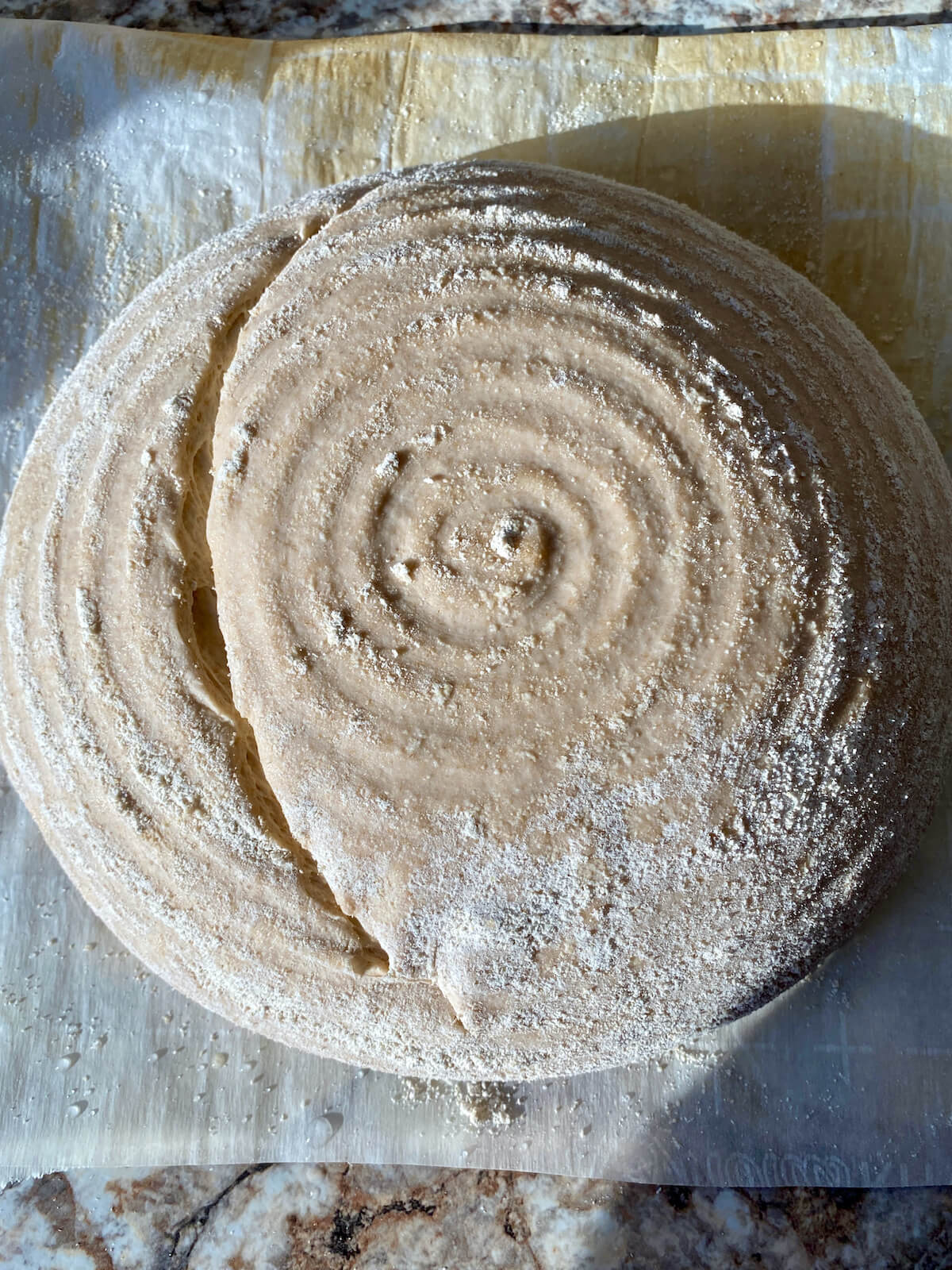
Step 12: Cool
Cooling the bread is critical for achieving a well-textured loaf. Cutting into a warm loaf of sourdough bread may cause it to have a gummy, dense texture.
Remove the bread from the Dutch oven and place it on a cooling rack. Allow the bread to cool for at least 2 hours before slicing.
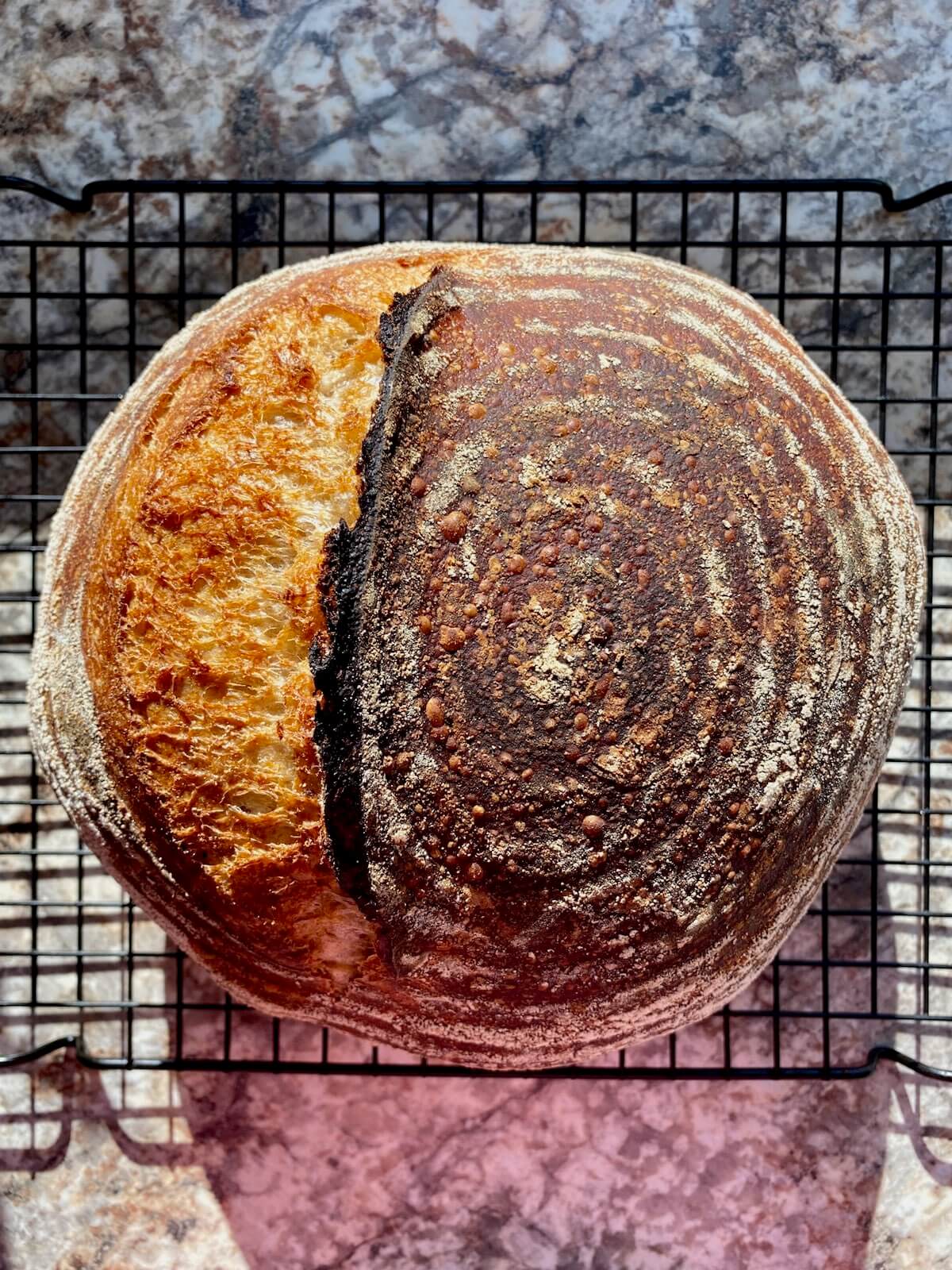
Sample Schedule
Here is an example of a schedule you can use to make this Dutch oven sourdough bread. The kitchen in this example is between 70-75°F and 35-40% humidity.
Day 1
8:00 AM: Feed Sourdough Starter.
1:30 PM: Autolyse
2:00 PM: Mix Dough
2:30-3:50 PM: Stretch & Folds
4:00-8:00 PM: Bulk Fermentation
8:00-8:20 PM: Pre-Shape
8:20 PM: Final Shape
8:30-9:00 PM: Proof
9:00 PM-9:00 AM (Next Day): Cold Retard
Day 2
8:00-9:00 AM: Preheat Dutch Oven
9:00-9:50 AM: Score and Bake
9:50-11:50 AM: Cool
Tips for Success
- Find the warmest spot in your kitchen. Place your sourdough starter and bread dough in the warmest spot in your kitchen, but keep it out of direct sunlight. Next to your stovetop, on top of the refrigerator, or inside the oven with the light on are a few ways to keep your sourdough warm.
- Make sure your sourdough starter is active. A healthy sourdough starter is essential for good bread. Make sure your starter is active and bubbly before using it in your dough.
- Weigh your ingredients. Measuring your ingredients by weight rather than volume is more accurate and can lead to more consistent results.
- Keep water nearby. Sourdough is a wet, sticky dough. To make it easier to handle, especially when stretching and folding, dipping your hands in water helps prevent sticking.
- Watch the dough, not the clock. Making sourdough bread is more of a process than a recipe. Look for tell-tale signs that your dough is ready rather than relying on the clock.
- Preheat your Dutch oven. Preheat your Dutch oven inside a 450°F (230°C) oven for at least 45 minutes before baking your sourdough bread in it.
Adding Mix-ins
From nuts and seeds to dried fruit, cheese, and chocolate, there are an endless variety of sourdough mix-ins to choose from. Once you master a basic loaf of sourdough bread, you can start getting creative by adding a little something extra.
Mix-ins are added during the stretch and fold phase. The amount you add varies depending on the ingredient and personal preference. Here are a few ideas:
- Seeds- You can mix in a variety of seeds, such as sesame, poppy, flax, sunflower, or pumpkin seeds, to add crunch and flavor.
- Nuts- Chopped nuts, such as walnuts, pecans, or almonds, can add a nutty flavor and texture to your bread.
- Dried Fruit- Dried fruit, such as raisins, cranberries, or apricots, can add sweetness and chewiness to your bread.
- Herbs- Fresh or dried herbs, such as rosemary, thyme, or basil, can add savory flavor to your bread.
- Cheese- Grated or cubed cheese, such as cheddar, Parmesan, or Gouda, can add a rich, savory flavor to your bread.
- Vegetables- Chopped or grated vegetables, such as jalapeños, carrots, zucchini, roasted garlic, or caramelized onions, can add moisture and nutrition to your bread.
- Spices- Ground spices, such as cinnamon, nutmeg, or cumin, can add warmth and complexity to your bread.
Note: When adding mix-ins to your sourdough bread, keep in mind that they can affect the dough's hydration and rise. So, you may need to adjust the amount of water accordingly.
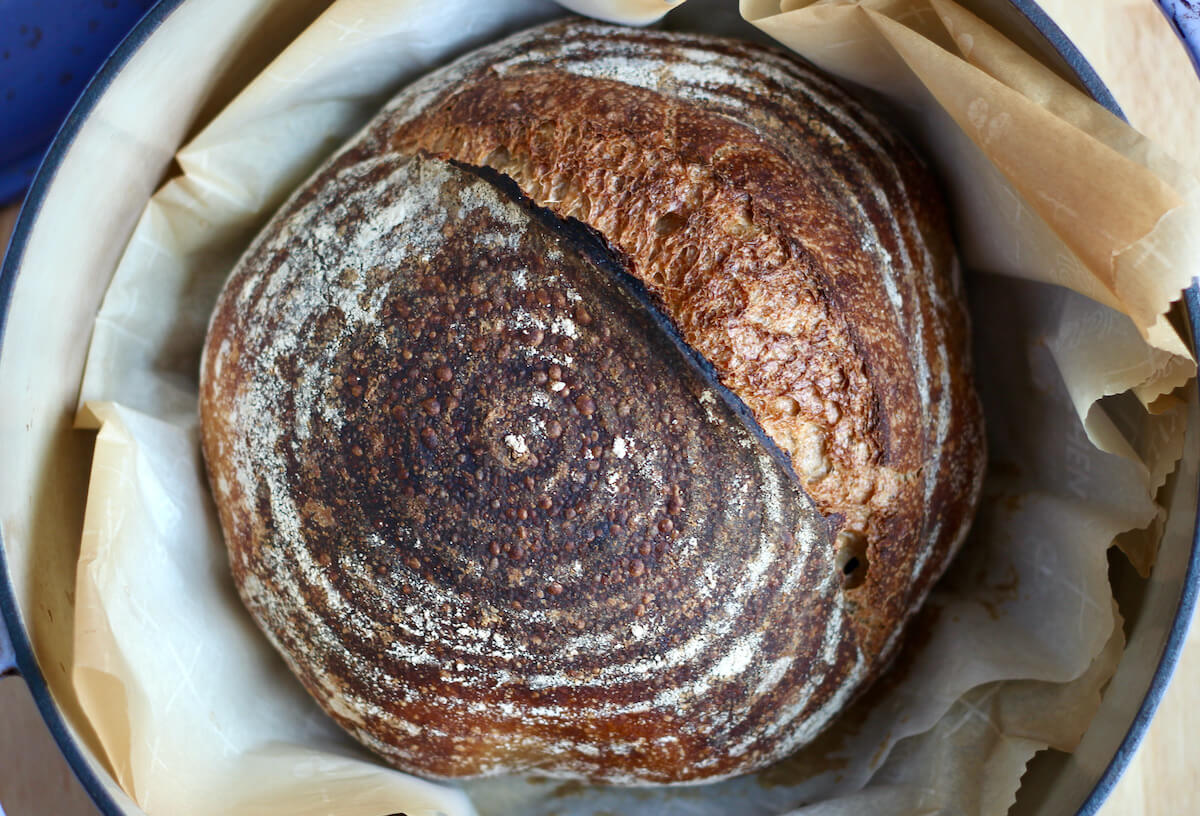
Storage
Since homemade sourdough bread doesn't contain preservatives, its shelf life is often shorter than store-bought bread. Sourdough bread is at peak freshness and is best enjoyed within the first 24 hours after baking.
Whole Loaf
- Room Temperature- Store an uncut loaf of sourdough bread on the counter at room temperature for up 4 days. After the first 24 hours, you'll want to store it in a bread bag or plastic bag to prevent it from drying out.
- Freezer- An uncut loaf of Dutch oven bread can be stored in the freezer for up to 3 months. To prevent freezer burn, double-wrap the loaf in plastic wrap and store it in a freezer-safe bag or container. Thaw at room temperature before slicing.
Sliced Loaf
- Room Temperature- A cut loaf of Dutch oven sourdough bread can be stored cut side down and covered with a tea towel on a cutting board for up to 2 days. Alternatively, if your loaf is cut into slices, store them in a plastic bag at room temperature for up to 3 days.
- Freezer- Slices of sourdough bread store well in the freezer and make it easier to grab what you need. Double-wrap sliced sourdough bread in plastic wrap, then place it inside a freezer-safe plastic bag for up to 3 months.
💡 Quick Tip: Never store sourdough bread in the refrigerator. The cool temperature and dry environment of a refrigerator will quickly harden and stale the bread. For best results, freeze sourdough bread you don't plan to eat within a few days.
How to Use Leftover Sourdough Bread
Don't toss that stale sourdough bread! There are many ways to use up leftover sourdough bread, even if it has become a little stale. Here are a few ideas:
- Breadcrumbs
- Croutons
- Garlic Bread
- Sourdough Stuffing
- French Toast or French Toast Casserole
- Bread Budding
- Panzanella Salad
- Grilled Cheese
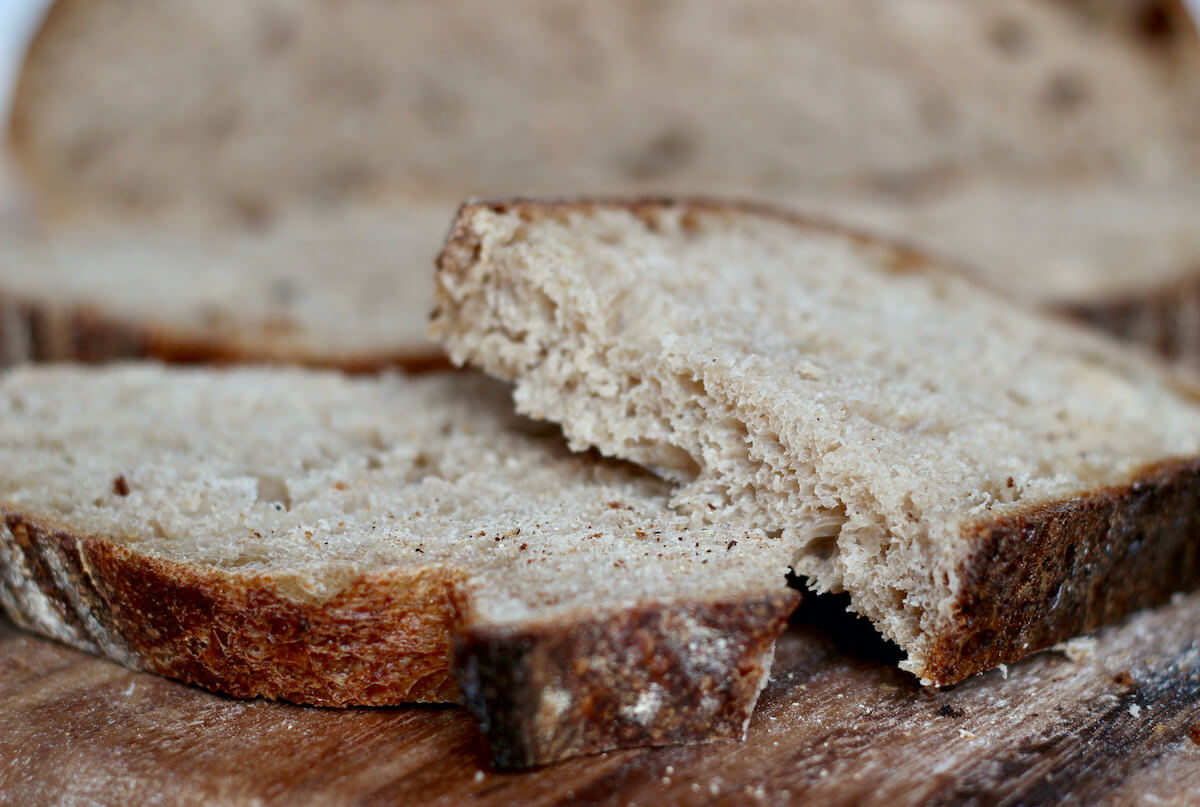
Frequently Asked Questions
While there are many brands selling Dutch ovens at a variety of price points, a good Dutch oven for sourdough bread baking should be at least 5 quarts in size, be round in shape, and have a tight-fitting lid to trap in steam.
A loaf of sourdough bread will take roughly 45-50 minutes to bake. Often, the lid is kept on for the first 25-30 minutes of baking to trap in steam and help with oven spring. Then, the lid is removed to darken the crust and finish cooking.
Yes, parchment paper helps prevent the bread from sticking to the bottom of the Dutch oven. It also creates a barrier between the bread and the direct heat from the pot, which stops it from burning on the bottom.
If your tap water is chlorinated, you don't want to use it to make sourdough starter or sourdough bread. Chlorine can interfere with the activity of the yeast and bacteria in your sourdough starter, making it more difficult to get a good rise.
Yes, you can use all-purpose flour in this recipe. However, using all-purpose flour may result in a slightly flatter, denser, less chewy loaf.
Resources
Learning the process of sourdough bread baking takes time, effort, and consistency. It took me months and a variety of resources to feel confident in my ability to bake a loaf of sourdough bread.
Here are some of my favorite sourdough bread resources:
- Understanding the Sourdough Bread Process by Baker Bettie
- Sourdough for Beginners (video playlist) by Baker Bettie
- Claire Saffitz Makes Sourdough Bread (video) by Dessert Person
Let's Connect!
Be sure to leave a comment below if you have any questions. You can also connect with me on Instagram, Facebook, Pinterest, or via email at [email protected].
📖 Recipe
Dutch Oven Sourdough Bread
Equipment
- Banneton optional
Ingredients
- 500 grams bread flour
- 375 grams water 80-90°F (26-32°C)
- 100 grams active sourdough starter
- 10 grams kosher salt
- Oat flour or rice flour for dusting banneton
Instructions
- Note: I recommend a general timeline below to help you get an idea of how long the process may take. However, keep in mind that sourdough recipes are more of a guideline than a step-by-step process to follow. Temperature, humidity, and the strength of your starter all play a role in how long it will take your dough to rise. It's more important to pay attention to how your starter and dough look rather than the amount of time that has passed. "Watch the dough, not the clock." Please see the blog post above for helpful images associated with each step.
- Feed Sourdough Starter (8:00 AM): Feed your sourdough starter in the morning on the day you want to make your dough. My starter takes about 6 hours to become active and bubbly when it's stored between 70-75°F (21-24°C). This will vary depending on where you store your starter, but signs to look for include: bubbles breaking on the surface of the starter, the starter doubling or tripling in volume, and a slight doming at the top of the starter. You can also use the float test* to check if your starter is ready to be added to your dough.
- Autolyse (1:30 PM): About 30 minutes before your starter is ready, thoroughly mix together the flour and water in a large mixing bowl. Make sure you incorporate the dry flour as best you can, which takes a few minutes of mixing. After mixing, the dough will look rough and shaggy. Cover and allow to rest for 30 minutes or up to 2 hours.500 grams bread flour, 375 grams water
- Mix the Dough (2:00-2:10 PM): Once your starter is ready, add it to the bowl with the flour and water. Spread it across the top of the dough, then use your fingertips to "dimple" it into the dough. Pull the dough over itself a few times to begin incorporating the starter. Then, sprinkle the salt over the dough and continue to squeeze and fold until both the starter and salt are fully incorporated. This will take about 2-3 minutes.100 grams active sourdough starter, 10 grams kosher salt
- Stretch & Folds (2:30-3:50 PM): Allow the dough to rest for 20 minutes after mixing. Then, perform your first set of stretch and folds. Do this by dipping your hand into a bowl of cold water before grabbing one edge of the dough and pulling it up as far as it will stretch before folding it over onto itself. Rotate the bowl 90 degrees and repeat. Repeat this stretching and folding two more times (for a total of 4 times) around the dough. Cover and allow the dough to rest for 20 minutes before performing another set of stretch and folds. Perform 5 sets of stretch and folds total.
- Bulk Fermentation (4:00-8:00 PM): Cover the dough and allow it to rise in a warm environment (70-75°F, 21-24°C) for about 4 hours. Your dough is ready when it doubles in size, has bubbles forming on the surface, and jiggles slightly when the bowl is shaken.
- Pre-Shape (8:00-8:20 PM): Carefully turn the dough out onto a lightly floured work surface, taking care not to deflate any of the air built up inside of it. Gently pull the dough into a rectangular shape. Then, using your hands or a bench scraper, lift one of the short sides of the rectangle, folding it over itself and onto the middle of the dough like a letter. Repeat this fold on the opposite side of the dough. For the longer edges of the rectangle, you'll want to pull the edge of the dough out and up slightly before folding it down onto the middle. Repeat on the other long edge. Brush away any flour on the work surface before quickly flipping the dough over so the seam side is on the counter. Use your hands or a bench scraper to gently round out the dough into a ball. Cover and allow it to rest for 15 minutes.
- Final Shape (8:20 PM): Lightly sprinkle the top of the dough with flour, then flip it over so the seam side is facing up again. Repeat the same shaping method followed in the pre-shape step, building a little more tension in the dough this time. Allow the dough to sit seam-side down on the counter for 1-2 minutes before transferring it to a proofing basket.
- Proof (8:30-9:00 PM): Generously dust a 9-inch round banneton (or tea towel-lined bowl) with rice flour or oat flour. Quickly turn the dough into the prepared banneton so that the seam side is facing up. Pinch the seam closed with your fingers if it seems to be opening up at all. Cover and allow it to proof at room temperature for about 30 minutes.
- Cold Retard (9:00 PM-9:00 AM the Next Day): Transfer the proofed dough to the refrigerator to retard overnight. This step helps enhance the classic "sour" flavor of sourdough bread. It also helps the dough hold its shape in the oven.
- Preheat Dutch Oven (8:00-9:00 AM the Next Day): About one hour before baking, place your Dutch oven and lid inside of the oven and preheat it to 450°F (230°C).
- Score and Bake (9:00-9:50 AM): Gently turn your dough out onto a piece of parchment paper. Using a lame, razor blade, or sharp bread knife, score your bread about ½-inch deep. Carefully transfer your dough on the parchment paper into the preheated Dutch oven. Quickly cover the Dutch oven and place it back inside the oven. Bake the bread covered for 30 minutes. Then, remove the lid and bake for an additional 15 minutes uncovered.
- Cool (9:50-11:50 AM): Remove the bread from the Dutch oven and place it on a cooling rack. Allow the bread to cool for at least 2 hours before slicing.
Notes
- *Float Test: To check if your starter is ready to use, gently scoop a small amount of starter out of the jar and carefully add it to a glass of cold water. If the piece of starter floats, you're good to go. If it sinks, it may need more time or is past its peak activity and needs to be fed again.
- Quick Tip: Place your sourdough starter and bread dough in the warmest spot in your kitchen, but keep it out of direct sunlight. Next to your stovetop, on top of the refrigerator, or inside the oven with the light on are a few ways to keep your sourdough warm. Ideal temperature is around 70-80ºF (21-26ºF).
- Storage: Store a whole, uncut loaf uncovered at room temperature for 24 hours. After 24 hours, transfer the loaf to a plastic bag for an additional 2-3 days. After 3 days, I recommend storing the loaf in the freezer. Store a sliced loaf in a plastic bag for up to 3 days, then transfer it to the freezer for longer storage.

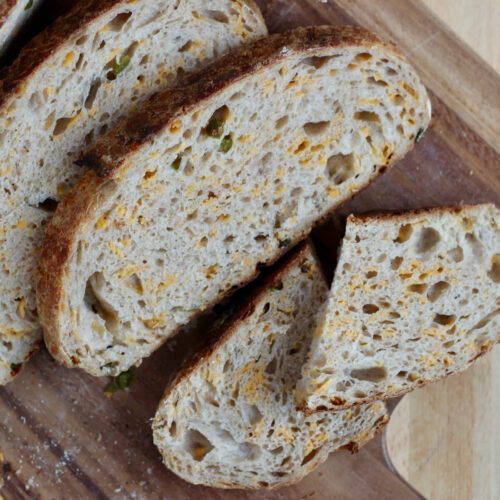
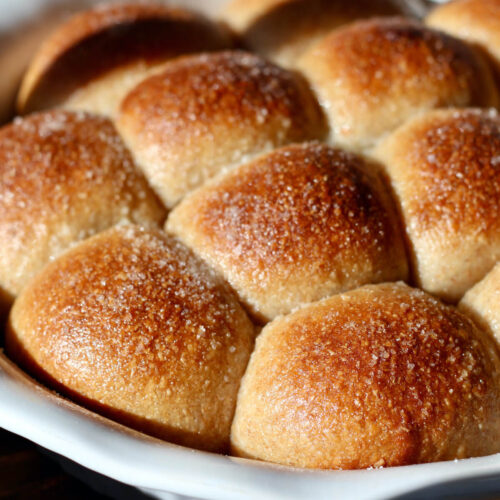
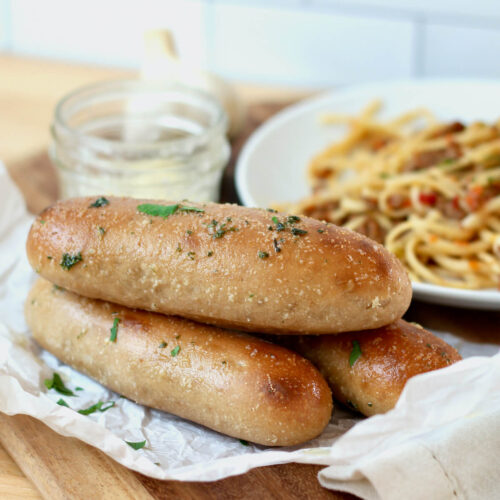

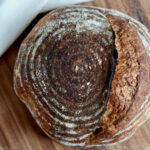




Comments
No Comments